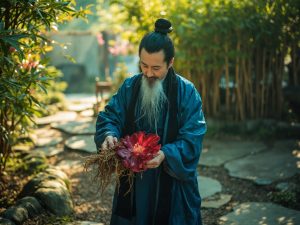Table of Contents
ToggleTraditional Chinese Medicine Case Analysis 9: No Bowel Movement for Over Ten Days, Fever, Delirious Speech
A Case Study of Traditional Chinese Medicine from Luo Jiao Annotation of the Guilin Ancient Edition of Shanghan Zabing Lun: [Treatment of Delirious Mania and Dysmenorrhea with Taoren Chengqi Tang]
Original Text:
A woman suffered from an epidemic disease, with a scorching hot body, oral erosion, thirst, and a preference for hot drinks. One day, she experienced delirium akin to madness. From her chest to her lower abdomen, there was hard pain that was intolerable to touch. She had not had a bowel movement for over ten days. The physician prescribed Taoren Chengqi Tang, and she passed black, smooth stools. All her symptoms disappeared.
Fang Yu Man Zhi states: This formula pattern (referring to Taoren Chengqi Tang pattern) is described in the original treatise as causing “lower bleeding” and “lower abdominal urgency and rigidity.” Compared to the Diding Tang pattern, the blood stasis is not yet deeply rooted. I would like to share one of my frequently proven cases: When menstrual blood was about to flow, the abdominal pain was unbearable, even reaching the point of mental agitation. I attacked it with Taoren Chengqi Tang, and after two or three doses, the pain disappeared as if by magic. This condition, which persisted for years and became a chronic illness, was due to the ineffectiveness of mild agents and weak decoctions.
During each menstrual period, taking two or three, or even four or five, doses of Taoren Chengqi Tang would alleviate the pain, and then the medication would be stopped. In the interval until the next menstrual period, agents like zhuyu wan san (blood-quickening and stasis-dispelling pills/powders) were taken. When the period arrived again, Taoren Chengqi Tang was resumed. After the period passed, a gentle attacking agent was taken again, as before. Repeating this cycle for four or five months could even cure long-standing chronic stagnant conditions.
Traditional Chinese Medicine Syndrome Differentiation Approach:
First, differentiate the Six Diseases:
Only Yangming disease is present, with no unfavorable urination or spontaneous urination, and no other six diseases. Symptoms: scorching hot body, oral erosion, hard pain from the chest to the lower abdomen with resistance to touch, no bowel movement for over ten days.
Next, differentiate Miscellaneous Diseases:
There is food retention: hard pain from the chest to the lower abdomen with resistance to touch, no bowel movement for over ten days. There is blood stasis: delirium akin to madness, thirst with a preference for hot drinks. No other miscellaneous diseases are present.
Summary:
This is a Yangming disease with food retention, primarily treated with a heat-clearing purgative method. The Taoren Chengqi Tang in the case is essentially equivalent to Tiaowei Chengqi Tang, with the addition of Guizhi and Taoren to descend and dispel blood stasis.
Shanghan Zabing Lun Clause Associated with this Traditional Chinese Medicine Case:
【Hu Xishu’s Interpretation of this Clause:】:
【Heat Congealing in the Bladder】
When Taiyang disease does not resolve at this stage, meaning it does not heal, it generally transmits to the interior. The disease progresses from the exterior to the semi-exterior/semi-interior and then to the interior, where it usually transmits to Yangming disease. However, it can also manifest as a blood stasis pattern in the “heat congealing in the bladder” area.
“Heat congealing in the bladder” does not mean heat congealed inside the bladder, but rather refers to the location. Ancient people referred to Guanyuan and the bladder, or “cold congealing in Guanyuan,” etc., simply to denote a particular area.
Blood stasis patterns are often found in the lower abdomen. Since people stand upright, fluids tend to settle downwards, especially what we now call blood stasis, or what Western medicine calls thrombus. These things most commonly accumulate in the abdominal and sacral regions.
The pelvic cavity and sacral region have a rich venous network, as described in anatomy and physiology. So, the “blood chamber” is located there. Of course, for women, it refers to the uterus, and for men, it refers to the area between the bladder and the large intestine. That’s why a kick to the lower abdomen can be fatal.
A blow to that area in the abdomen can cause significant blood accumulation in the venous network because blood tends to settle. Since blood often accumulates there, it can lead to “heat congealing in the bladder”! It’s not that there’s anything inside the bladder. This disease is not in the bladder. Some people nowadays say it’s a disease of the Taiyang fu (organ); this is nonsense. The bladder is perfectly fine. To say that the Taoren Chengqi Tang pattern indicates a disease of the Taiyang fu is simply absurd.
【The Person Becomes Like a Madman】
“The person becomes like a madman” indicates that blood stasis is strongly related to the cerebral system.
In clinical practice, I have frequently used this method of treating cerebral system diseases caused by blood stasis.
Mental illnesses are often caused by blood stasis. As blood stasis circulates, some turbid and noxious qi can easily impact the brain, leading to the person becoming like a madman, or even going mad. Ancient people referred to blood stasis as “vicious blood.” For true mental illness with blood stasis, this formula is quite effective.
【Blood Self-Discharges, and Upon Discharge, the Condition Resolves】
【Treatment Principle When Exterior Syndrome Has Not Resolved (First Resolve the Exterior, Then Attack the Interior)】
He is discussing the exterior syndrome, Taiyang disease. “If the exterior has not resolved, it is not yet advisable to attack internally.” Like Yangming disease, if the exterior has not resolved, it is not yet advisable to attack internally. This condition is not in the stomach but in the lower abdomen.
So, if there is an exterior syndrome, resolve the exterior first. By implication, resolving the exterior would use Guizhi Tang. If there is a Mahuang Tang pattern, Mahuang Tang can be used.
“Once the exterior has resolved,” meaning there is no longer an exterior syndrome, “if only the lower abdomen is rigid and urgent,” and the person is like a madman, and the lower abdomen feels urgent. “Urgent” here is similar to the “urgency in the epigastrium” we discussed for Dachaihu Tang pattern—it means a feeling of distention. At the same time, it is “rigid,” meaning there is resistance upon palpation. “Then it can be attacked.” At this point, if the problem is only in the lower abdomen, Taoren Chengqi Tang can be used.
Formula: Taoren Chengqi Tang
Source: Shanghan Zabing Lun
Composition:
- Taoren (Peach Kernel): 50 pieces (peeled and pointed)
- Dahuang (Rhubarb): 4 liang
- Guizhi (Cinnamon Twig): 2 liang
- Gancao (Licorice): 2 liang (prepared)
- Mangxiao (Mirabilite): 2 liang
Preparation: Simmer the first four ingredients in 7 sheng of water until 2 sheng remain. Remove the dregs, add Mangxiao, and bring to a slight boil. Remove from heat. Take 5 ge warm before meals, three times a day. There should be a slight bowel movement.
Hu Xishu’s Formula Pattern:
【Composition of Taoren Chengqi Tang】
This formula is a modification of Tiaowei Chengqi Tang. It adds Guizhi to descend upward surging qi and Taoren to dispel blood stasis.
If there is interior heat, add Guizhi and Taoren. Taoren is a powerful herb for dispelling blood stasis, and we use it very frequently.
Guizhi is included because the person is like a madman, and turbid, noxious qi surges upward. Guizhi descends surging qi; otherwise, the head condition would not improve, as the turbid, noxious qi surges up to the brain.
【Taoren Chengqi Tang vs. Diding Tang】
If there is existing blood stasis that does not manifest without other triggers but occasionally flares up during an external contraction, like a cold, when Taiyang disease is about to transmit to the interior, blood stasis may become apparent, and the person may go mad. At this point, whether to use Taoren Chengqi Tang or Diding Tang depends on the circumstances.
If the disease is more severe and the blood stasis is difficult to attack, Diding Tang is more likely to be used.
If the person’s symptoms are not so severe, like in Taoren Chengqi Tang, where the person is like a madman and the lower abdomen is rigid and urgent, but not hard and full. Diding Tang involves a hard and full lower abdomen, and the congealed substance is also firm, whereas Taoren Chengqi Tang is merely rigid and urgent.
In Taoren Chengqi Tang, the person is like a madman and sometimes has bleeding. Diding Tang absolutely does not cause bleeding. Therefore, the blood stasis in Diding Tang is more stubborn, and using only Taoren is insufficient, which is why it includes Zhiru (Leech) and Mengchong (Gadfly larva). At the same time, it does not use Gancao. Blood stasis patterns are commonly seen in the lower abdomen, with symptoms like lower abdominal rigidity and urgency. Taoren Chengqi Tang and Diding Tang both address lower abdominal fullness. So, lower abdominal urgency and abdominal fullness are all signs of blood stasis, and these manifestations are present in abdominal examination, especially in the lower abdomen.
【When to Apply Taoren Chengqi Tang】
In clinical application, if there is a Tiaowei Chengqi Tang pattern, with internal blood stasis, upward surging qi, the person being like a madman, or having lower abdominal rigidity and urgency, these are all symptoms for which Taoren Chengqi Tang can be used.
“Fullness below the chest and hypochondria, like a knotted chest, with delirium” can be treated with Xiaochaihu Tang. In my personal clinical experience, the opportunity to use Xiaochaihu Tang alone is not frequent; generally, it is more often combined with Taoren Chengqi Tang or Guizhi Fuling Wan. You need to assess whether it can be purged. If it can be purged, and there is delirium and no bowel movement for several days, you can use Dachaihu Tang, Guizhi Fuling Wan, or Taoren Chengqi Tang. If it cannot be purged, and the stool is not dry but rather loose, then combining Xiaochaihu Tang with Guizhi Fuling Wan is also quite effective.
【Relationship Between Bleeding Symptoms and Blood Stasis】
Many bleeding symptoms are due to blood stasis. Therefore, simply stopping bleeding when encountering bleeding symptoms can be very detrimental.
Many bleeding symptoms are due to blood stasis. If you don’t dispel the stasis, the bleeding will not stop.
If there is a Taoren Chengqi Tang pattern, Taoren Chengqi Tang can be used. The Taoren Chengqi Tang pattern belongs to Yangming. Delirium and forgetfulness are related to the brain. Therefore, blood stasis plays a significant role in madness, mania, and epilepsy.
When using medication, we must deliberate. For excess patterns, we use Guizhi Fuling Wan and Taoren Chengqi Tang; these are for excess patterns. If there is blood stasis in a deficiency pattern, Guizhi Fuling Wan and Taoren Chengqi Tang not only cannot dispel the blood stasis but will harm the patient! You should use strengthening blood-quickening and stasis-dispelling herbs, which can both dispel blood stasis and improve the deficiency.
【Management of Lochiorrhea (Unresolved Postpartum Discharge)】
If the lochiorrhea is a disease in itself, we can use purgatives such as Taoren Chengqi Tang or anything suitable. If it cannot be purged, Guizhi Fuling Wan or similar formulas can also be used to dispel lochiorrhea.
However, if it’s not a disease in itself, but purely influenced by interior heat of Yangming, leading to congealed lochia that doesn’t flow, then Dachengqi Tang alone is sufficient.
Disclaimer:
The experiences and insights shared above represent the author’s personal usage and understanding, and are provided for reference only as part of academic exchange. Please do not blindly replicate or apply them; any consequences arising from such actions are solely your responsibility. As individual constitutions vary, medication should be tailored accordingly. It is advisable to use such treatments under the guidance of a qualified physician. If you have additional experiences to share, comments and submissions are welcome.
If you appreciate my article, please give it a like.
If you are a generous and affluent individual, please consider making a donation!
Your recognition is my greatest motivation to continue writing—thank you very much!
USD Donation Button —
A RMB donation button is available below.
 微信赞赏
微信赞赏 支付宝赞赏
支付宝赞赏




